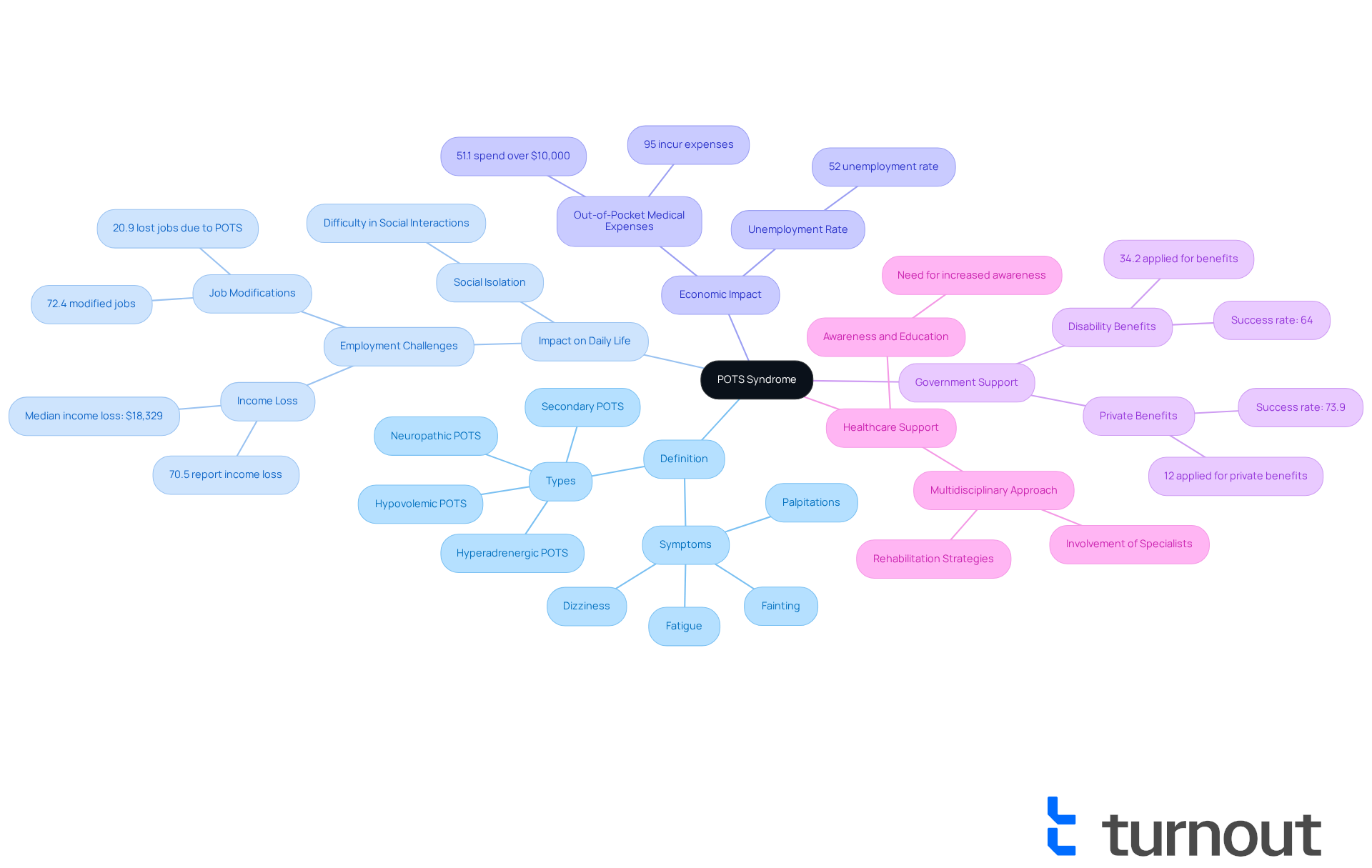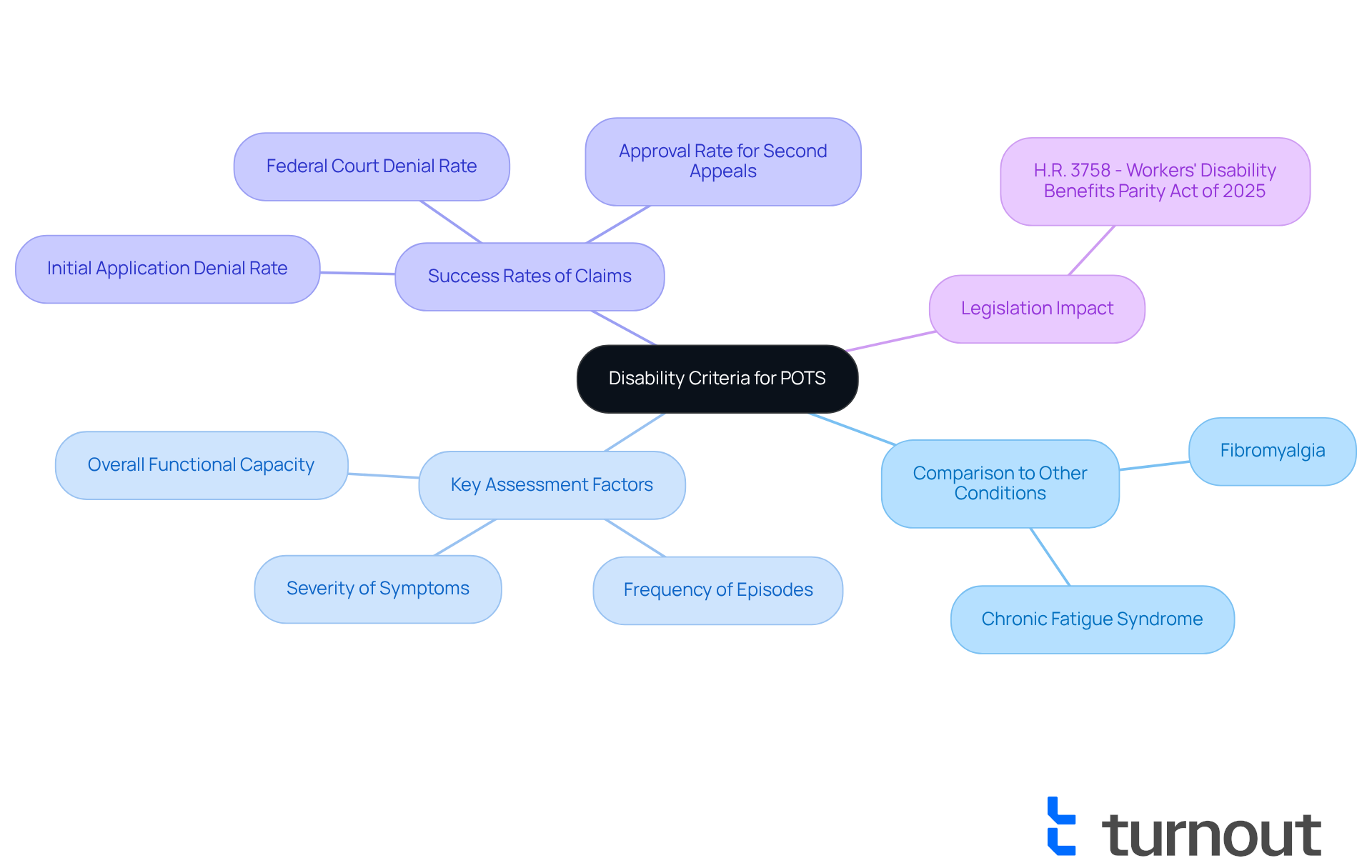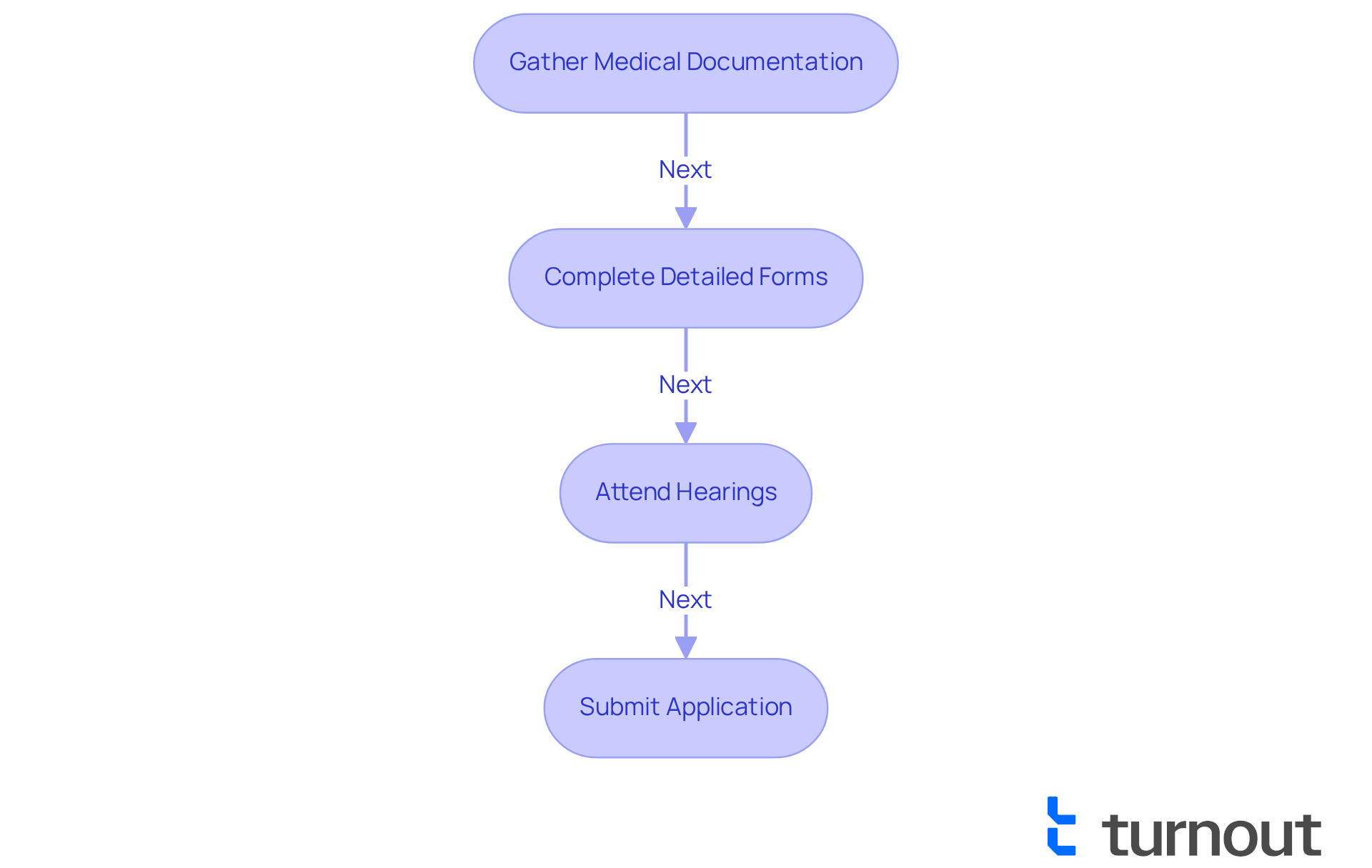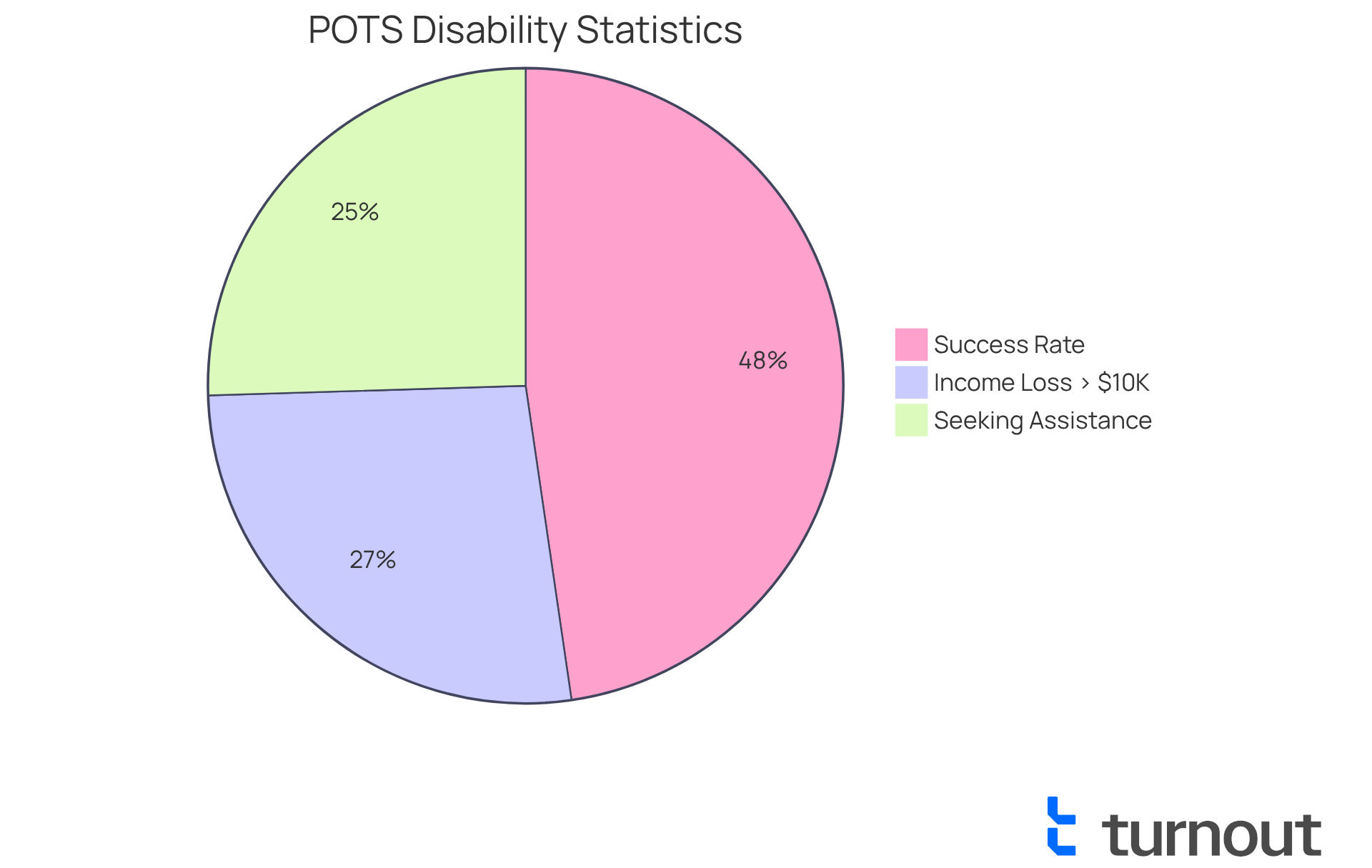Overview
POTS syndrome profoundly affects daily life, employment, and income, often leading many individuals to seek government assistance. We understand that this journey can be overwhelming. Statistics reveal high rates of income loss and significant challenges in obtaining disability benefits, highlighting the importance of comprehensive documentation. It’s common to feel uncertain about how to navigate these obstacles.
As we explore the realities of POTS, it's crucial to recognize that awareness of this condition as a legitimate disability is essential. You are not alone in this journey. Many face similar struggles, and together, we can advocate for better understanding and support. We encourage you to seek the assistance you need and to document your experiences thoroughly. Remember, we're here to help you every step of the way.
Introduction
Postural Orthostatic Tachycardia Syndrome (POTS) presents a unique challenge for those affected, often leading to significant disruptions in daily life and employment. We understand that grappling with debilitating symptoms like dizziness and fatigue can be overwhelming. As individuals navigate these difficulties, the question of whether POTS qualifies as a disability becomes increasingly pertinent.
This article delves into the complexities of POTS syndrome, exploring its profound impact on individuals' lives. We aim to shed light on the criteria for disability benefits and the hurdles faced in navigating the application process. It's common to feel uncertain and frustrated amidst the skepticism surrounding invisible illnesses. How does one secure the necessary support in such challenging circumstances?
Together, we will explore the avenues available for assistance and support, ensuring you know that you are not alone in this journey.
Understanding POTS Syndrome: Definition and Impact
Postural Orthostatic Tachycardia Syndrome (POTS) is a condition that can significantly impact your daily life. It’s characterized by a considerable rise in heart rate when standing, leading to debilitating symptoms such as dizziness, fatigue, palpitations, and fainting. We understand that the consequences of this condition can be overwhelming, often hindering your ability to carry out regular tasks, maintain employment, or engage in social activities.
Recent studies indicate that about 70.5% of individuals with POTS report income loss due to their symptoms, with a median income loss of $18,329 in the past year. Additionally, 34.2% of those diagnosed have sought government disability benefits, achieving a success rate of 64%. This highlights the significant barriers many face when seeking financial assistance.
Real-world examples illustrate the profound effect of POTS on employment. Nearly 66.8% of employed participants wish they could work more hours if not for their health limitations, while 20.9% have lost a job directly because of their condition. The challenges extend beyond the workplace; many individuals experience difficulties in social interactions, often feeling isolated due to their symptoms.
Healthcare professionals emphasize the need for increased awareness and understanding of the question of whether POTS syndrome is considered a disability. As one expert noted, this condition poses a serious risk for reduced employment and economic loss, which raises the question of whether POTS syndrome is considered a disability given the functional limitations it imposes. The complexity of POTS, often misattributed to psychological factors, requires a comprehensive approach to diagnosis and support. It’s essential that those affected receive the accommodations needed to navigate their daily lives effectively.
Turnout offers vital tools and services to assist individuals with POTS in managing the complexities of government support, particularly regarding SSD claims and tax debt relief. By utilizing trained nonlawyer advocates, Turnout simplifies the application process, ensuring you receive the necessary support without the burden of legal representation. Understanding the various categories of POTS—Neuropathic, Hyperadrenergic, Hypovolemic, and Secondary forms—is crucial, as these classifications can influence treatment and support strategies.
Moreover, the average diagnostic delay for POTS is approximately 5 years and 11 months, complicating the journey to obtaining the recognition and support you deserve. With a high unemployment rate of 52% among patients with POTS, the economic impact of this condition is profound. Adaptive employment practices could provide essential support for individuals navigating these challenges. Lastly, many individuals with POTS face significant out-of-pocket medical expenses, further exacerbating their financial burdens. Remember, you are not alone in this journey, and there are resources available to help.

Disability Criteria: How POTS Compares to Other Invisible Illnesses
Disability criteria for Postural Orthostatic Tachycardia often mirror those for other hidden conditions like Chronic Fatigue Syndrome and Fibromyalgia. The Social Security Administration (SSA) evaluates these conditions based on their impact on a person's ability to work and perform daily tasks. Key assessment factors include:
- Severity of symptoms
- Frequency of episodes
- Overall functional capacity
It's important to note that CFS evaluations may place more emphasis on fatigue levels and cognitive impairments. Understanding these standards is crucial for those seeking assistance, as it underscores the significance of thorough medical records and personal accounts during the application process.
Many individuals with postural orthostatic tachycardia syndrome are often left wondering if POTS syndrome is considered a disability when applying for disability benefits. It's common for applicants to report that their claims are often denied due to the unseen and fluctuating nature of their conditions. Statistics show that about 65 percent of initial applications for Social Security disability are denied, highlighting the necessity for strong medical evidence. Additionally, individuals with postural orthostatic tachycardia syndrome may experience comparable levels of disability, raising the question of whether POTS syndrome is considered a disability similar to those with chronic obstructive pulmonary disease or heart failure. However, their claims can be met with skepticism due to the lack of visible indicators.
The success rates for disability claims related to invisible illnesses remain low, with only around 35 percent of initial applications approved. This reality emphasizes the need for applicants to provide detailed documentation on how their symptoms affect their daily lives and work capabilities. Furthermore, the introduction of H.R. 3758, the Workers' Disability Benefits Parity Act of 2025, aims to promote equal treatment for mental health and substance use conditions in long-term disability. This legislation may positively influence the assessment of similar conditions in the future. Remember, you are not alone in this journey, and we are here to help you navigate these challenges.

Navigating the Application Process: POTS vs. Other Invisible Illnesses
Navigating the application process for disability benefits can be especially challenging for individuals with Postural Orthostatic Tachycardia Syndrome (POTS), particularly regarding whether POTS syndrome is considered a disability. We understand that this journey often involves gathering extensive medical documentation, completing detailed forms, and possibly attending hearings. Unlike other unseen conditions, such as Multiple Sclerosis (MS), where physical indicators may be more apparent, POTS requires a more subtle approach to illustrate its effects.
It's important to keep detailed documentation of indicators, treatments, and their impact on your everyday life. For instance, a study revealed that 70.5% of individuals with POTS reported a loss of income due to their condition, highlighting the significant financial strain they face. Utilizing assistance from healthcare professionals who understand POTS can greatly enhance your application. Their insights can provide essential context for evaluators.
This support is crucial, especially since insurers often misinterpret the variable nature of POTS manifestations as non-disabling, leading to complications in determining if POTS syndrome is considered a disability during the approval process. Real-world examples show that applicants who provide comprehensive documentation and detailed narratives linking their symptoms to occupational limitations have a better chance of success.
Turnout, while not a law firm and not providing legal advice, offers tools and services to assist individuals in navigating these complexities. They utilize trained nonlawyer advocates to help with Social Security Disability (SSD) claims, streamlining access to governmental assistance. This ensures that you can effectively present your case without needing legal support.
Overall, the challenges in illustrating the effects of POTS compared to other unseen illnesses highlight the need for greater awareness and understanding of whether POTS syndrome is considered a disability among disability assessors. Remember, you are not alone in this journey; we're here to help.

Outcomes of Disability Benefits: POTS in Context with Other Conditions
Navigating the process of obtaining disability support for conditions like postural orthostatic tachycardia syndrome (POTS) can feel overwhelming, especially when considering if POTS syndrome is considered a disability. We understand that this journey often differs significantly from those with other hidden illnesses. While many individuals with POTS manage to secure benefits, the path is frequently lengthy and filled with obstacles. For instance, individuals with Crohn's disease may find it easier to document their conditions due to visible symptoms and established treatment protocols. In contrast, to effectively communicate its debilitating effects, it is important to address whether POTS syndrome is considered a disability.
Data shows that 34.2% of individuals with POTS have sought government assistance, achieving a success rate of 64%. Yet, the road to these benefits is not without its challenges. Many POTS patients report significant income loss, with 70.5% indicating they have lost income due to their symptoms. Alarmingly, 36% have experienced losses exceeding $10,000 in the past year. This financial pressure underscores the crucial need for effective advocacy. Organizations like Turnout streamline access to government assistance and financial support through expert guidance and tools designed for Social Security Disability (SSD) claims and tax debt relief.
Real-life stories demonstrate how vital support can be in navigating the complexities of the benefits system. Successful outcomes can lead to improved access to healthcare, financial stability, and a better quality of life. However, the process often demands persistence and the backing of informed supporters, such as those at Turnout. They help articulate how this condition impacts daily activities. As one participant shared, the invisible nature of POTS symptoms complicates the claims process. Claimants must provide comprehensive medical documentation and personal narratives that truly reflect their experiences.
It's essential to note that Turnout is not a law firm and does not provide legal advice, particularly regarding whether POTS syndrome is considered a disability. Instead, they employ trained nonlawyer advocates who assist clients in navigating the SSD claims process. Ultimately, while the potential for obtaining benefits exists, the journey is fraught with challenges that require determination and support from those familiar with the intricacies of the system. Remember, you are not alone in this journey—we're here to help.

Conclusion
Postural Orthostatic Tachycardia Syndrome (POTS) presents significant challenges that can profoundly affect daily life and overall well-being. We understand that navigating these difficulties can be overwhelming. The exploration of whether POTS is considered a disability highlights the complexities surrounding its recognition and the barriers individuals face in seeking support. Understanding POTS and its implications is crucial for those on this often arduous journey toward obtaining necessary accommodations and benefits.
This article delves into the substantial impact of POTS on employment and finances. Many individuals experience severe income loss and difficulties maintaining jobs due to their symptoms. It's common to feel frustrated and alone in this struggle. The comparison of POTS with other invisible illnesses underscores the need for thorough documentation and strong medical evidence when applying for disability benefits. Unfortunately, statistics indicate that a significant percentage of claims are denied, emphasizing the importance of presenting a compelling case that articulates the condition's effects on daily functioning.
Ultimately, raising awareness about POTS and advocating for its recognition as a legitimate disability is vital. You are not alone in this journey; individuals grappling with this condition should know that resources and support systems are available to assist in navigating the complexities of disability claims. By fostering greater understanding and empathy, society can help ensure that those living with POTS receive the assistance they need to improve their quality of life and financial stability. Together, we can make a difference.
Frequently Asked Questions
What is Postural Orthostatic Tachycardia Syndrome (POTS)?
POTS is a condition characterized by a significant rise in heart rate upon standing, leading to symptoms such as dizziness, fatigue, palpitations, and fainting.
How does POTS impact daily life?
POTS can severely hinder daily activities, employment, and social interactions due to debilitating symptoms, often resulting in feelings of isolation.
What is the economic impact of POTS on individuals?
Approximately 70.5% of individuals with POTS report income loss, with a median loss of $18,329 in the past year. Many have sought government disability benefits, achieving a 64% success rate.
How does POTS affect employment?
Nearly 66.8% of employed individuals with POTS wish to work more hours if not for their health limitations, and 20.9% have lost jobs directly due to their condition.
Is POTS considered a disability?
There is ongoing discussion among healthcare professionals about whether POTS should be classified as a disability due to its significant functional limitations and economic impact.
What types of POTS exist?
The main categories of POTS include Neuropathic, Hyperadrenergic, Hypovolemic, and Secondary forms, which can influence treatment and support strategies.
What challenges do individuals with POTS face in obtaining a diagnosis?
The average diagnostic delay for POTS is about 5 years and 11 months, complicating access to recognition and support.
What resources are available for individuals with POTS?
Turnout offers tools and services to help individuals manage government support, including assistance with SSD claims and tax debt relief, using trained nonlawyer advocates.
What is the unemployment rate among individuals with POTS?
The unemployment rate among patients with POTS is approximately 52%, highlighting the economic burden of the condition.
Are there significant medical expenses associated with POTS?
Yes, many individuals with POTS face substantial out-of-pocket medical expenses, which can further exacerbate their financial difficulties.




